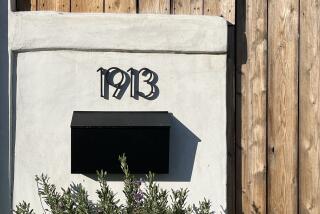Home builder sees a future with movable walls and garage-less houses
- Share via
In the future, most homes won’t have garages because their owners won’t own cars. Rooms can be reconfigured by pushing the walls. Postal service or bike couriers might not be necessary -- drones will handle many package and take-out deliveries.
At least, that’s KB Home’s vision. As part of the Greenbuild International Conference and Expo last month, the home builder imagined residential living circa 2050 by constructing an 1,800-square-foot model home in the Los Angeles Convention Center.
The sleek concept includes cutting-edge Jetsons technology. But much of the innovation is also based on major changes in demographics and social attitudes.
The three-car garage — once a conspicuous signal of homeowner prosperity — will become a rarity, as driving yourself is replaced by on-demand travel via Uber, Lyft and other ride-sharing options, KB Home predicts. Car owners will have charging stations for their Teslas and other electric vehicles.
To account for future drone delivery services, such as the kind Amazon.com is testing, KB Home dreamed up a secure drop box paired with a landing pad. Drones would ping the home’s smart network to open a chute, then drop packages in.
Internally, the concept home incorporates a modular design. Walls can be moved along tracks to convert spaces. Certain components — counters, bars, even full bathrooms — will eventually be prefabricated and dropped into homes as easily as ink cartridges into a printer, designers said.
Modularity gives residents options in limited spaces.
Properties are shrinking, due partly to rising premiums for land. In the 20 largest U.S. metropolitan areas, the average new apartment built between 2010 and 2016 is 7% smaller than a unit built between 2000 and 2010, real estate consultancy RCLCO found. Tiny homes, eco-capsules and other miniaturized living areas are becoming more common.
An American Institute of Architects survey this year found that formal dining rooms and living rooms will fade away in the next decade, replaced by dens, great rooms and other open layouts. Those communal gathering spaces could be morphed into bedrooms or offices.
Residents also want spaces that are accessible to all ages. As the population grays, homeowners can maintain independence by shifting walls and altering rooms to adapt to their new needs — a concept known as aging in place.
“Homes will have a smaller footprint in the next few decades,” said Dan Bridleman, senior vice president of technology and sustainability at KB Home. “But they can still be creative, dynamic spaces.”
Some technologies showcased in the KB Home model are updates of existing, even vintage ideas. A wall of edible plants growing in the kitchen, for instance, harkened back to when the average dinner table featured produce from the backyard garden.
The KB Home prototype was built around a wooden frame. But experts said future building materials could include wax-like insulation that would reduce the need for air conditioning. Other alternatives include bamboo, resins used for 3-D printing, and bricks grown with bacteria.
Down the line, connected homes could be biometrically attuned to inhabitants, adjusting lighting, temperature and even scent according to personal preferences, experts said. Mirrors could feature facial recognition.
But American homeowners tend to be cautious about adopting new innovations and are even less inclined toward expensive ones.
“The options are limitless at this point, but they still have to be attainable,” Bridleman said. “We still want to get people into these homes. We can do really cool stuff, but what’s more important is that we come up with ways to offset technology and material costs to keep houses affordable.”
More to Read
Sign up for Essential California
The most important California stories and recommendations in your inbox every morning.
You may occasionally receive promotional content from the Los Angeles Times.





